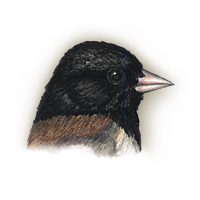|
Field
Guide IDs: BREEDING:
Conif and decid
forest and edge, open woodland, bogs. 2 broods, occ
3 in s, 1 at higher elevation and
latitude. DISPLAYS:
Courting pair hop
with wings drooped, tail fanned displaying white
outer feathers; from low perch male droops wings,
spreads and droops tail, sings softly. NEST:
Usu in shallow
depression with overhead protection, often against
vertical surface; rarely in shrub, tree, or
building; of coarse grass, moss, rootlets, forbs,
bark, twigs, lined with fine materials, EGGS:
White to pale
bluish-white, marked with reddish-browns, often
wreathed. 0.8" (19 mm). DIET:
Includes few
spiders; wide variety of seeds. Nestlings fed 100%
insects, initially partly regurgitated. CONSERVATION:
Winters s to n
Mexico. Uncommon cowbird host. NOTES:
Territorial
conflict uncommon. Female broods nestlings. Later
clutches smaller. Rapid tarsal development enables
nestlings to run from nest if threatened before
they can fly. Foraging flocks occ with chickadees,
bushtits, nuthatches, kinglets, sparrows, in spring
and fall. Roosts in conif trees, old nests, rock
crevices, on ground. Winter flocks of 10-30 with
definite social ranking and mutually exclusive
foraging territories. Males tend to winter farther
n than females. Several races, formerly regarded as
species, now combined in Dark-eyed Junco:
Slate-colored, Oregon, White-winged, Gray-headed,
and Guadalupe Junco. Uncommon and local
summer resident, fairly common and more widespread
during migration and in winter. Breeding birds on
main campus nest almost exclusively in dense mats
of ivy and other vines planted around buildings and
courtyards, although the choice of nesting cover
may be more diverse in woodland and scrub habitats
near the Dish and in the faculty housing area. From
fall through spring, flocks (sometimes fairly large
in the Arboretum) occur virtually throughout
campus. ESSAYS: Eye
Color;
Walking
vs. Hopping;
Birds
and the Law;
Dominance
Hierarchies;
Taxonomy
and Nomenclature REFERENCES:
Balph, 1979;
Ketterson and Nolan, 1982; Smith and Andersen,
1982. |
